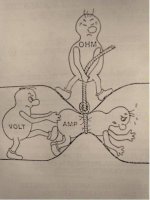those signal wires aren't thick enough
I recommend thinner wire. I'm using 2 twisted- wire wrap wire that's 30 gauge for inputs.
those signal wires aren't thick enough

You mean the sound could get stuck in the wire? 😀😀😀
The signal wiring needs to be thick enough to allow the electrons to bounce around.
That gives the euphonic effect so liked by the tube/valve Members.
That gives the euphonic effect so liked by the tube/valve Members.
You mean the sound could get stuck in the wire? 😀😀😀
Imagine the sound signal is a human. And the cable is a pipe tunnel. It is okay if the signal has limited bass content. What if there is plenty of bass content? Its like a very fat man going through a tunnel. Some part of his body might be distorted. 😱😀
Matthias,
Now I know that I have twisted your arm hard enough...! You can be proud, you didn't need much help. Your amps really turned out very nice!
Martin
Now I know that I have twisted your arm hard enough...! You can be proud, you didn't need much help. Your amps really turned out very nice!
Martin
You mean the sound could get stuck in the wire? 😀😀😀
Attachments
AWG Wire Sizes
Years ago, when I tuned my DIY f-4 monoblocks, Mr. Peter Daniel send me the following link: American Wire Gauge table and AWG Electrical Current Load Limits with skin depth frequencies
According this hint I used single pairs of thin wires taken from LAN Class-5 cable for monoblocks inputs.
My supply and speakers wires are thicker.
a.
Years ago, when I tuned my DIY f-4 monoblocks, Mr. Peter Daniel send me the following link: American Wire Gauge table and AWG Electrical Current Load Limits with skin depth frequencies
According this hint I used single pairs of thin wires taken from LAN Class-5 cable for monoblocks inputs.
My supply and speakers wires are thicker.
a.
Last edited:
The signal wiring needs to be thick enough to allow the electrons to bounce around.
That gives the euphonic effect so liked by the tube/valve Members.
Maybe 🙂
I would have thought the wire need to be thin enough for the signal not to be trapped into the wires 😀
😉
Best,
nAr
amusing and yet accurate analogy.
The sort of thing pupils might remember for the rest of their lives.
Thanks for the smile.
The sort of thing pupils might remember for the rest of their lives.
Thanks for the smile.
-2x30v switching PSU from a linn music system (doesn't sag at all, doesn't run hot)
-DIY PCB's, as small as possible. the way i always make PCB's 😉

(i've committed a small grounding sin in this picture, but there was no hum so i left it like that for the testrun)
and it sounds lovely. i will run the final casing with some slow and silent fans because this heatsink isn't up to the task for normal use. for short tests it's just enough.
-DIY PCB's, as small as possible. the way i always make PCB's 😉

(i've committed a small grounding sin in this picture, but there was no hum so i left it like that for the testrun)
and it sounds lovely. i will run the final casing with some slow and silent fans because this heatsink isn't up to the task for normal use. for short tests it's just enough.
It is funny you are talking about switch mode power supplies.-2x30v switching PSU from a linn music system
I just bought 2 x 500W switch mode power supplies today just to see how they go.
I have been wanting to try this forever and today I bought a pair.
See how they compare when I get them
hi i am building my aleph 30
it is said this amp no need adjustment.
in my amp the dc at speaker out is 0 to 5mv on left, but always -22mv on right.
how to balance both amp?
thanks.
An externally hosted image should be here but it was not working when we last tested it.
Hi, got a pair of that pcb once on my desk, I think you'll have to change R11 to 1k multi turn trimpot, may be paralleled with 400R, good luck
You mean the sound could get stuck in the wire? 😀😀😀
yep!
pinch the wire during a song and then let go...the song will come out all at once.
You can find some pics of the Aleph J construction. I made the J for a friend and for now he appreciates it very much 😉
http://sdrv.ms/Nferwc
Best,
nAr
http://sdrv.ms/Nferwc
Best,
nAr
- Home
- Amplifiers
- Pass Labs
- Pictures of your diy Pass amplifier

